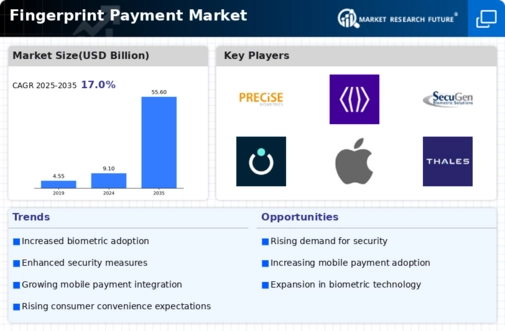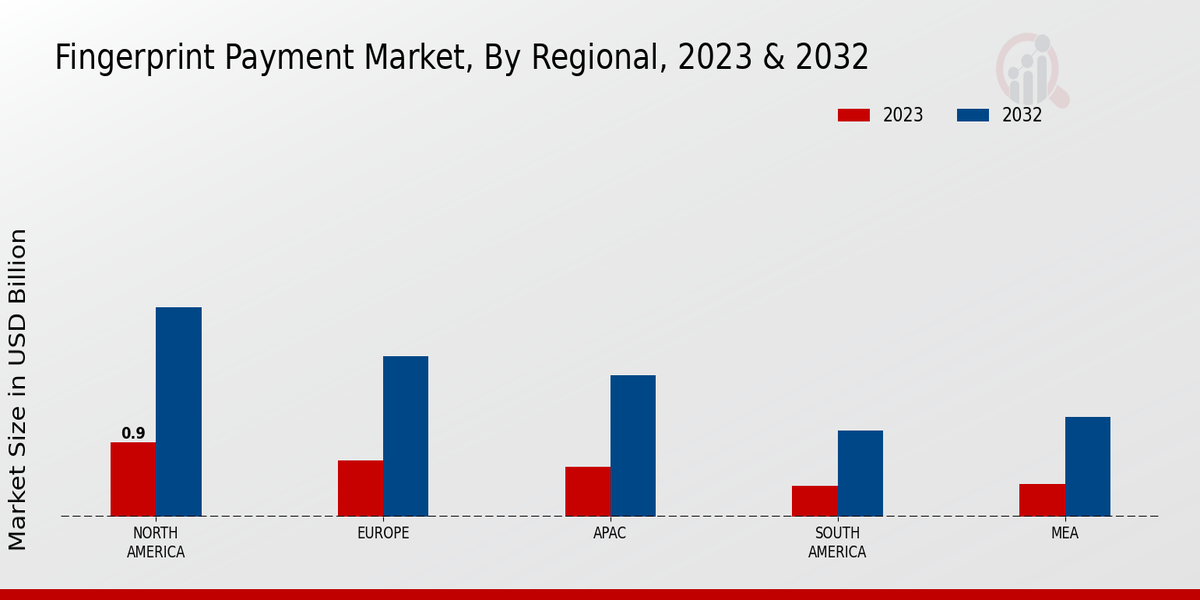Market Growth Projections
The Global Fingerprint Payment Market Industry is poised for substantial growth, with projections indicating a market size of 9.1 USD Billion in 2024 and an anticipated increase to 55.6 USD Billion by 2035. This growth trajectory suggests a compound annual growth rate (CAGR) of 17.88% from 2025 to 2035. Such figures underscore the increasing acceptance and integration of fingerprint payment systems across various sectors. The market's expansion is driven by factors such as rising demand for contactless payments, enhanced security features, and technological advancements in biometric systems. As the industry evolves, it is likely to witness further innovations and increased adoption rates.
Enhanced Security Features
Security concerns remain a pivotal driver for the Global Fingerprint Payment Market Industry. Biometric authentication, particularly fingerprint recognition, provides a robust layer of security that traditional methods struggle to match. With increasing incidents of fraud and identity theft, consumers and businesses alike are gravitating towards solutions that offer enhanced protection. The unique physiological characteristics of fingerprints make them difficult to replicate, thus instilling greater confidence in users. This heightened security is likely to catalyze the adoption of fingerprint payment systems across various sectors, including banking and retail, contributing to the projected market growth to 55.6 USD Billion by 2035.
Growing Adoption in Emerging Markets
Emerging markets represent a significant opportunity for the Global Fingerprint Payment Market Industry. As these regions experience rapid economic growth and increased smartphone penetration, the demand for innovative payment solutions rises. Countries in Asia and Africa are witnessing a shift towards digital payments, with fingerprint technology being a preferred choice due to its convenience and security. Governments and financial institutions are actively promoting cashless transactions, further driving the adoption of biometric payment systems. This trend is expected to contribute to the overall market growth, as emerging economies increasingly embrace fingerprint payment solutions to enhance financial inclusion and streamline transactions.
Rising Demand for Contactless Payments
The Global Fingerprint Payment Market Industry experiences a notable surge in demand for contactless payment solutions. As consumers increasingly prefer seamless and efficient transaction methods, fingerprint payment systems offer a convenient alternative. In 2024, the market is projected to reach 9.1 USD Billion, reflecting a growing inclination towards biometric authentication. This trend is particularly evident in retail and e-commerce sectors, where speed and security are paramount. The integration of fingerprint technology into mobile wallets and point-of-sale systems enhances user experience, potentially driving further adoption. As a result, the Global Fingerprint Payment Market Industry is poised for significant growth in the coming years.
Regulatory Support for Biometric Payments
Regulatory frameworks are increasingly supporting the adoption of biometric payment systems, thereby influencing the Global Fingerprint Payment Market Industry. Governments worldwide are recognizing the potential of biometric technologies to enhance security and streamline payment processes. Initiatives aimed at promoting digital payments often include provisions for biometric authentication, which can bolster consumer trust. This regulatory backing not only encourages businesses to invest in fingerprint payment solutions but also fosters a conducive environment for innovation. As regulations evolve to accommodate biometric technologies, the market is likely to expand, paving the way for a more secure and efficient payment landscape.
Technological Advancements in Biometric Systems
Technological innovations play a crucial role in shaping the Global Fingerprint Payment Market Industry. Advances in fingerprint recognition technology, such as improved sensors and algorithms, enhance the accuracy and speed of biometric authentication. These developments not only improve user experience but also expand the applicability of fingerprint payments in diverse environments. For instance, the integration of fingerprint scanners in smartphones and wearables facilitates seamless transactions. As technology continues to evolve, the market is likely to witness increased adoption rates, with a projected compound annual growth rate (CAGR) of 17.88% from 2025 to 2035, indicating a robust future for the Global Fingerprint Payment Market Industry.













